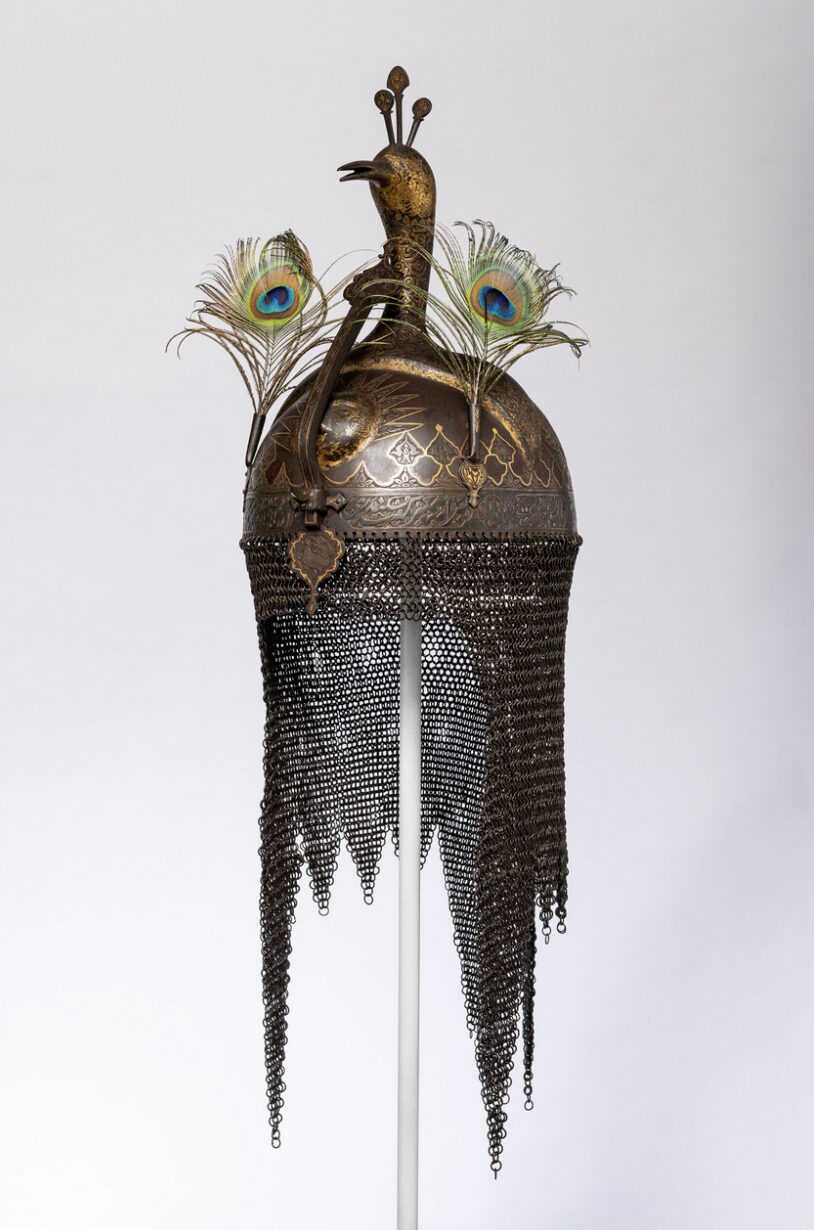The diabolical ironclad beetle can withstand a force 39,000 times its body weight. In what ways does this tiny beetle inspire modern engineers?
That question is one of many explored in the Bruce Museum’s new exhibition “Arms and Armor: Evolution and Innovation,” on view March 7-Aug. 11.

Kulah Khud Helmet 18th-19th century, Persia Bruce Museum Collection 16831.03 Gift of Miss Amelia F. MacFarlane Photo by Paul Mutino
“Arms and Armor” explores the parallel ways natural selection and human innovation influence the shape, composition and function of structures ranging from turtle shells to chain mail.
Weapons and armor from around the world are displayed side-by-side with natural history specimens such as taxidermy, skeletons and fossils.
Rather than being grouped culturally or taxonomically, objects are arranged by shared function.
Examples abound and include segmented armor that provides lightweight, flexible protection, and thus has arisen hundreds of times in the animal world in species ranging from centipedes to armadillos. Japanese samurai developed a similar style of armor, using overlapping bands of lacquer-plated metal. Heavier plate armor provides better protection but limits movement. In the exhibition, this paradigm is exemplified by juxtaposing the bony plate armor of the giant, extinct fish Dunkleosteus with the steel suits of armor worn by knights during the Middle Ages.

Placoderm Fish Skull (cast) Dunkleosteus marsaisi Photo by Paul Mutino
“In terms of protecting ourselves from threats, there are incredible connections between human innovation and animal evolution throughout history,” said Daniel Ksepka, Ph.D., curator of science at the Bruce Museum. “This exhibition highlights those parallels with profoundly captivating objects, from 17th century dueling swords to the jaws of Tyrannosaurus rex.”
An unexpected example on view compares the Aztec macuahuitl, a club lined with razor sharp obsidian, to the fangs of the vampire bat. These weapons each derive efficacy from razor-sharp edges that easily cut into their target. While the edges of the bat incisors are honed through intentionally grinding away the dentin layer of the teeth, the edges of the human weapon are created by carefully fracturing volcanic glass.
Beyond shared functions, the exhibition explores how intraspecies competition can lead to impressive and even bizarre weaponry. The sharp horns of the steenbok antelope and the prominent pincher-like cranial projections of the Hercules beetle provide striking examples of features that are used to battle rivals rather than ward off predators. The unwieldy horns of the Hercules beetle in many ways mirror the long wooden lances used by jousting knights. Neither structure is ideal for lethal combat, but both are perfect for ritualized competition.

Samurai Helmet Edo Period, Japan Bruce Museum Collection Gift of Mrs. Matthew E. Hanna Photo by Paul Mutino
“Many of the most remarkable natural weapons evolve not for hunting or defending against predators but for competing with members of one’s own species,” Ksepka said. “When competition for mates or resources is channeled into ritual aggression, it can lead to structures that are wildly impractical for normal activity, but which give an animal the upper hand in interspecies combat.”
Other pairs represented include a Persian Kulah Khud helmet with a nine-banded armadillo, a sawfish rostrum with a cavalry saber and the blade of a navaja folding knife with the common housecat’s teeth. The objects on view come from the Bruce Museum collection, as well as loans from the Worcester Art Museum (Worcester, Massachusetts), Stamford Museum & Nature Center (Stamford, Connecticut), Yale Peabody Museum (New Haven, Connecticut) and private collectors.

Shortspine Porcupinefish (skeleton) Diodon liturosus Photo by Paul Mutino

Kukri Age unknown, Nepal Bruce Museum Collection 08783 Gift of Heinrich Dueringer Photo by Paul Mutino
Located in Bruce Park overlooking Greenwich Harbor, the Bruce Museum is a community-based, world-class institution that offers a changing array of exceptional exhibitions and educational programs to promote the understanding and appreciation of art, science and the intersections between the two disciplines. Now considered ahead of its time for taking this multidisciplinary approach over a century ago, the Bruce Museum is at the heart of contemporary efforts to bring together art, science, technology and creativity to generate moments of discovery and dialogue.
The first exhibition at the Bruce Museum took place in 1912 and featured works by local artists known as the Greenwich Society of Artists, several of whom were members of the Cos Cob Art Colony. Their works formed the nucleus of the Museum’s art holdings and continue to be a strength of the collection, which has expanded to focus on global art from 1850 to the present. Other strengths include Ancient Chinese sculpture, Native American Art, the Hudson River School, modernist works on paper and photography. Parallel development of the natural sciences includes strengths in the mineral and avian collections. In all, the community, through its generosity, has built the Museum’s varied collections of art and natural science to over 30,000 objects.
In 2019, the Museum, which is accredited by the American Alliance of Museums, broke ground on a new building that doubled the size of the museum and tripled the exhibition spaces. The new Bruce opened April 2, 2023, featuring state-of-the-art exhibition, education and community spaces, including a changing gallery for art and five new permanent galleries in the William L. Richter Art Wing; a changing gallery for science; the Robert R. Wiener Mineral Gallery, a permanent science exhibition, “Natural Cycles Shape Our Land;” three classrooms in the Cohen Education Wing; a café; an auditorium and grand hall. When the outdoor spaces are completed in summer 2024, the new Bruce campus will feature a sculpture-lined, landscaped walking path and inviting spaces for relaxation and contemplation—natural enhancements to Bruce Park and an anchoring connection to Greenwich Avenue.